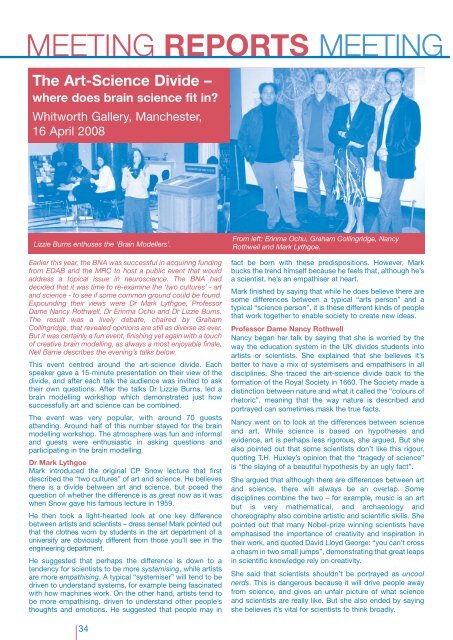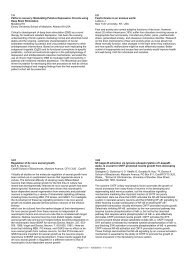MEETING REPORTS MEETINGDangerous sports:boxing clever?11th March, at The DanaCentre, London, SW7A public café-bar discussion, chaired by Gaetan Lee(Science Museum), and involving Mark Burford (Cityboxer,London), Peter Dangerfield (ring-side medic, University ofLiverpool), Mike Loosemore (English Institute of Sport) andDaniel Sokol (medical ethicist, St George’s Hospital,London). Yvonne Allen describes the evening.Call me an ‘old softie’ if you want (and many do), but I alwaysthought there was something distinctly unsavoury aboutplacing men in a roped enclosure and watching them basheach other about until one collapses, either with exhaustionor severe concussion. And this in the name of ‘sport’?However, despite bristling with prejudice, I tried to go with anopen mind and a sense of curiosity (one always does) to theDana Centre last March, prepared at least to finish theevening better informed and less bigoted than when I arrived(one always is).So, imagine, here I am, glass of merlot in one hand, bag ofTyrell crisps in the other (for, yes, it is that kind ofestablishment), waiting to be convinced or otherwise thatboxing is a noble sport and that the BMA is up itsown…err…nether regions in wanting it banned.The evening begins with the speakers introducing theirprofessional interest in the sport and stance they are comingfrom. From this, it is clear, perhaps a little disappointingly, thatwe are not going to have much of a punch-up here tonight asthey were all supportive of the sport continuing (though fordifferent reasons). It also became apparent that amateur andprofessional boxing are two different ‘animals’; the amateurgame is highly regulated, has fewer rounds and heads areprotected – the emphasis being as much on skilful defence asmuch as aggressive attack. Conversely, all conceded that theprofessional game is much more overtly aggressive, the endpointbeing ideally a ‘knock-out’, the opponent falling ‘punchdrunk’and (invariably) bleeding in an exhausted heap, formatches can be anything up to 15 rounds. Moreover, theprofessional game can be infiltrated by rather unscrupulous‘promotors’, and the stakes are indeed high, with huge sumsof money lost or won in such a short space of time. It is littlewonder the mafia took – and still do take- quite an interest.But let’s return to the point: is boxing clever? On the positiveside, we are told that boxing is a great work-out. You have toexercise virtually every muscle in your body so the healthbenefits from this extreme cardiovascular experience areimmense. Moreover, the sport is classless and cheap, anyonecan join in. Indeed, youngsters who are failing in theacademic stakes can gain high esteem for their prowess inthe ring instead. The sport is very fair, for opponents arecarefully matched for weight, size and skill, and it is highlyregulated – witness the proverbial attention of the medicalprofession at the ringside and beyond. Finally, it is claimedthat boxing can channel aggression away from the streets.Indeed, many boxers insist the sport ‘rescued’ them from alife of crime though, statistically, this is hard to verify, ofcourse, and is largely anecdotal.Fine then. The sport seems healthy, clean, safe, fair, nobleand socially responsible, so why on earth is the BMA trying toban it? The BMA, of course, is concerned medically with thelong-term brain damage of repeated blows to the head, andthere are certainly some high-profile examples (MohammedAli, for one) that would support their case. However, the panelwere adamant that boxing injuries are far less common thanother sports (such as rugby, horse-riding, skiing, racing – thelist goes on) and there are virtually no fatalities (at least in theamateur game). So the medical case grows weaker and moresuspect. We are only then left with the moral case instead:can it be right that men can be encouraged to punchthemselves silly egged on by a baying crowd? How can thissit comfortably in a society where GBH is a criminal offenceand smacking children is wrong? OK, conceded, other sportsare more dangerous. But in no other sport is there the actualintent to do harm, is there?Not surprisingly, at this point, the discussion moved on towomen, children and old people. Many in the audience (andsome of the panel now) did have more difficulty with theconcept of women fighting, though no-one was prepared tosuggest it should be specifically banned – no-one dared! Theage constraints of 11-34 years for the amateur andprofessional game alike virtually deny the middle-aged toelderly and the very young from participating, so we can beageist but not sexist, it seems. But there are more reasons, ofcourse, why these groups are more vulnerable. Brain injurycan be exacerbated in older brains because sub-duralspaces are wider, making vessels more vulnerable to rupture,for instance; the older brain is also more sensitive todehydration; and women should have pregnancy tests beforefighting, it was suggested, because of potential risks to theunborn child. It was generally agreed, however, that the riskswere low and that the danger of developing breast cancerfrom blows to the chest (yes, really!) was a bit of a myth.At this point, it was a member of the audience who nowmoved the discussion on to white collar or ‘city boxing’, asit’s called, an activity that first emerged among theprofessional classes in New York City, and was originallydesigned to alleviate stress of a lunchtime. Relatively newand far less regulated, it was not surprising that the panelwere a little more uneasy about its existence alongside itslong-established mentor.Finally, out of interest, someone asked if there had ever beenany precedent for banning boxing in other countries. Yes, wasthe answer, most notably Sweden, but it was re-introducedthere in the 1980s after careful consideration of the physicalrisks that were, eventually, agreed to be minimal.And so the evening drew to a close, and I was left much wiserand a little less condemning of boxing as a sport. I nowunderstood the clear distinction between the amateur and theprofessional game, I was more convinced that boxing is nomore dangerous than a bout on the rugby field, and I hadbeen persuaded that it has a useful social role to play,especially for those unable to aspire to greater things in otherways. Its participants, often less educated and articulate thanthe mighty intellectuals of the BMA, are clearly disadvantagedwhen arguing their case. No fair contest then – unlike a boutof boxing (ha!).33
MEETING REPORTS MEETINGThe Art-Science Divide –where does brain science fit in?Whitworth Gallery, Manchester,16 April 2008Lizzie Burns enthuses the ‘Brain Modellers’.Earlier this year, the BNA was successful in acquiring fundingfrom EDAB and the MRC to host a public event that wouldaddress a topical issue in neuroscience. The BNA haddecided that it was time to re-examine the ‘two cultures’ - artand science - to see if some common ground could be found.Expounding their views were Dr Mark Lythgoe, ProfessorDame Nancy Rothwell, Dr Erinma Ochu and Dr Lizzie Burns.The result was a lively debate, chaired by GrahamCollingridge, that revealed opinions are still as diverse as ever.But it was certainly a fun event, finishing yet again with a touchof creative brain modelling, as always a most enjoyable finale.Nell Barrie describes the evening’s talks below.This event centred around the art-science divide. Eachspeaker gave a 15-minute presentation on their view of thedivide, and after each talk the audience was invited to asktheir own questions. After the talks Dr Lizzie Burns, led abrain modelling workshop which demonstrated just howsuccessfully art and science can be combined.The event was very popular, with around 70 guestsattending. Around half of this number stayed for the brainmodelling workshop. The atmosphere was fun and informaland guests were enthusiastic in asking questions andparticipating in the brain modelling.Dr Mark LythgoeMark introduced the original CP Snow lecture that firstdescribed the “two cultures” of art and science. He believesthere is a divide between art and science, but posed thequestion of whether the difference is as great now as it waswhen Snow gave his famous lecture in 1959.He then took a light-hearted look at one key differencebetween artists and scientists – dress sense! Mark pointed outthat the clothes worn by students in the art department of auniversity are obviously different from those you’ll see in theengineering department.He suggested that perhaps the difference is down to atendency for scientists to be more systemising, while artistsare more empathising. A typical “systemiser” will tend to bedriven to understand systems, for example being fascinatedwith how machines work. On the other hand, artists tend tobe more empathising, driven to understand other people’sthoughts and emotions. He suggested that people may inFrom left: Erinma Ochu, Graham Collingridge, NancyRothwell and Mark Lythgoe.fact be born with these predispositions. However, Markbucks the trend himself because he feels that, although he’sa scientist, he’s an empathiser at heart.Mark finished by saying that while he does believe there aresome differences between a typical “arts person” and atypical “science person”, it is these different kinds of peoplethat work together to enable society to create new ideas.Professor Dame Nancy RothwellNancy began her talk by saying that she is worried by theway the education system in the UK divides students intoartists or scientists. She explained that she believes it’sbetter to have a mix of systemisers and empathisers in alldisciplines. She traced the art-science divide back to theformation of the Royal Society in 1660. The Society made adistinction between nature and what it called the “colours ofrhetoric”, meaning that the way nature is described andportrayed can sometimes mask the true facts.Nancy went on to look at the differences between scienceand art. While science is based on hypotheses andevidence, art is perhaps less rigorous, she argued. But shealso pointed out that some scientists don’t like this rigour,quoting T.H. Huxley’s opinion that the “tragedy of science”is “the slaying of a beautiful hypothesis by an ugly fact”.She argued that although there are differences between artand science, there will always be an overlap. Somedisciplines combine the two – for example, music is an artbut is very mathematical, and archaeology andchoreography also combine artistic and scientific skills. Shepointed out that many Nobel-prize winning scientists haveemphasised the importance of creativity and inspiration intheir work, and quoted David Lloyd George: “you can’t crossa chasm in two small jumps”, demonstrating that great leapsin scientific knowledge rely on creativity.She said that scientists shouldn’t be portrayed as uncoolnerds. This is dangerous because it will drive people awayfrom science, and gives an unfair picture of what scienceand scientists are really like. But she also ended by sayingshe believes it’s vital for scientists to think broadly.34
















